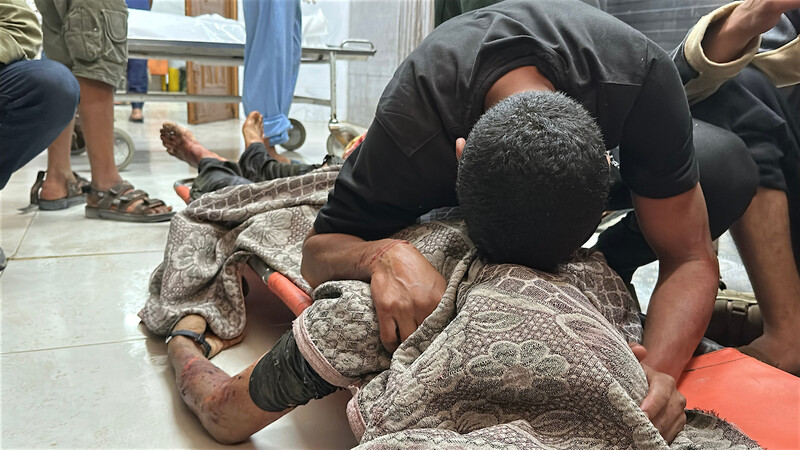Gaza is the slaughterhouse
Nora Barrows-Friedman Rights and Accountability23 May 2025

More than 700 Palestinians were killed in one week in Gaza.
Moaz Abu Taha APA imagesThe following is from the news roundup during the 22 May livestream. Watch the entire episode here.
Israeli attacks across Gaza have killed more than 700 Palestinians between 15 and 21 May, according to the latest figures from the Palestinian health ministry, as starvation continues to spread after more than 80 days of Israel’s blockade.
At least 160 were killed in 24 hours on Sunday, 18 May, including at least 40 in a massacre targeting displacement tents in Khan Younis.
In Jabaliya, Beit Lahiya and Gaza City in northern Gaza, Israeli airstrikes killed more than 200 Palestinians in a 48-hour period between 16 and 17 May, according to the Gaza government media office.
“Among the martyrs, 140 remain under the rubble as a result of the Israeli occupation army’s deliberate denial of access to the bombed areas in northern Gaza,” the office added.
The Israeli attacks in northern Gaza, which it is calling Operation Gideon’s Chariots, are “transforming the area into an open and systematic killing zone.”
Mahmoud Shebrawi, a young man in Jabaliya, filmed himself hiding from Israeli quadcopter shooting on Tuesday, 20 May.
Forced displacement orders
On Tuesday, the Israeli military issued further displacement orders, affecting 26 neighborhoods in northern Gaza, specifically in Beit Lahiya, Jabaliya and its refugee camp, the UN said.
The affected area spans about 35 square kilometers and represents 10 percent of the Gaza Strip, the UN added, noting that its humanitarian partners “estimate that as of midday Tuesday, more than 41,000 people were displaced.”
About 81 percent of all of Gaza’s territory now falls within Israeli-militarized zones or has been placed under displacement orders, the UN said on Wednesday.
In Khan Younis, in southern Gaza, the Israeli military issued displacement orders for 90 percent of the city area.
Hind Khoudary of Al Jazeera reported on 19 May, “We saw people evacuating under fire, holding whatever they could carry, and the Israeli forces [told] those Palestinians to evacuate to al-Mawasi in Khan Younis,” which, she adds, has been targeted continuously by Israeli forces.
That same day, 19 May, Israeli commandos, disguised as Palestinian civilians, shot and killed a man and detained his wife and child during a raid on a house in Khan Younis.
Al Jazeera reported that Israeli forces drove a civilian vehicle and raided the home as air strikes pounded the surrounding area, residents said.
Mahmoud Safi, a relative of the family, said that Israeli troops carried what appeared to be luggage and blankets on the top of their vehicle. The assassinated man was identified as Ahmed Sarhan, a leader of the armed wing of the Popular Resistance Committees.
At least five other people were killed in the raid, in addition to Sarhan, according to medical sources.
Donya Abu Sitta, who is a contributor to The Electronic Intifada and has appeared on this livestream, wrote in Drop Site News that “according to witnesses, they killed [Sarhan] in front of his family and kidnapped his wife and children and shot dead another child in the street on their way out.”
She witnessed the airstrikes covering for the raid on Sarhan and his family.
“I saw F-16 fighter jets and Apache helicopters flying very close by – so close, I felt like I could reach out and touch them,” Abu Sitta reports.
“It was the first time I ever witnessed a missile fired from a warplane. I saw the massive orange fireball unleashed as the bomb exploded not far away.”
Abu Sitta added that the Israeli military had carpet bombed the area, launching over 40 airstrikes in 40 minutes, on some accounts.
Hospitals targeted
Hospitals continue to be besieged and forced out of service by Israeli attacks.
Late Wednesday night, the Israeli military shellednorthern Gaza’s Al-Awda Hospital, while drones also bombed water tanks at the health facility, according to Al Jazeera.
Israel attacked the Nasser Medical Complex in Khan Younis yet again this week, targeting its small warehouse of essential supplies.
The warehouse included critical supplies such as prosthetic limbs, IV fluids and dialysis solutions.
Dr. Munir al-Bursh, director general of the Palestinian health ministry in Gaza, said that the damage caused by the Israeli airstrike on the warehouse at Nasser Medical Complex “comes at a time when the stock levels of more than 45 percent of essential medicines had already reached zero,” and basic medical supplies or those needed for surgical operations had exceeded 60 percent in shortages even before this week’s attack.
Nasser Medical Complex was attacked on 13 May as Israeli forces assassinated a journalist in a bombing that destroyed the hospital’s burn unit.
In addition, the Israeli military bombed the European Gaza Hospital in Khan Younis, also on 13 May.
Since then, the hospital has been rendered out of service. The Electronic Intifada spoke with Dr. Majed Jaber, an emergency room physician at the European Gaza Hospital, who survived the bombing and said that it was the last medical facility that was able to provide basic care to cancer patients, and now the entire hospital is out of service following a series of Israeli attacks.
On 19 May at the Indonesian Hospital in Beit Lahiya, in northern Gaza, Israeli forces surrounded and besieged the facility as Israeli airstrikes targeted the power generators and fuel tanks to operate the generators, sparking a massive fire.
Staff and patients were forced to flee on foot, trying to maneuver gurneys over massive piles of rubble on the destroyed streets.
“The health situation in the northern Gaza Strip is catastrophic after the Indonesian Hospital was put out of service,” the ministry said, adding that every single hospital in Gaza is collapsing from a lack of fuel and the spare parts needed for generators.
Tom Potokar, a British surgeon working at the Indonesian Hospital, recorded this video after the attacks. “If Cambodia was the killing fields, then Gaza now is the slaughterhouse,” he said.
Trickle of humanitarian aid
Israel announced earlier this week that it was allowing several trucks of humanitarian aid into Gaza, after 80 days of complete closure and an engineered humanitarian disaster.
“These aid trucks were allocated to a number of international and civil society organizations, as part of efforts to distribute them to the Palestinian people to meet some of their urgent humanitarian needs,” the media office stated.
The 87 trucks that entered Wednesday evening are just a drop in the bucket compared with the staggering need in Gaza.
Some 44,000 aid trucks should have entered since 2 March, when Israel closed the crossings in flagrant violation of all international humanitarian laws.
Gaza requires around 500 aid trucks and 50 fuel trucks daily to meet the minimum humanitarian needs of its population, the media office stated.
The United Nations’ humanitarian office noted that the Israeli authorities are requiring the UN to offload supplies on the Palestinian side of Karim Abu Salem/Kerem Shalom crossing and reload them separately once they secure UN teams’ access from inside.
Only then is the UN able to bring any supplies closer to where people in need are sheltering.
On 20 May, the Gaza media office stated that 326 deaths had been recorded due to malnutrition, food and medicine shortages, and more than 300 miscarriages among pregnant women were reported over the last 80 days.
The humanitarian situation in the Gaza Strip has reached catastrophic levels in every sense of the word, the office stated.
Euro-Med Human Rights Monitor said on 21 May that it had documented the deaths of 26 Palestinians, including nine children, in just a 24-hour period.
“These deaths are the result of a deliberate Israeli policy that weaponizes hunger and denial of treatment to kill Palestinian civilians. The tightened blockade, in place since 2 March, disproportionately targets the most vulnerable and turns the man-made humanitarian catastrophe into a central tool of extermination.”
Israeli lawmakers gloat about genocide
Meanwhile, Israeli lawmakers have been boasting that they are enjoying the destruction of Gaza and are calling for its entire ethnic cleansing, while the so-called international community not just watches, but continues to arm and abet these genocidal war crimes and crimes against humanity.
Bezalel Smotrich, the Israeli finance minister, saidthat Israeli forces intend to “level all of Gaza” just as they levelled Rafah. In remarks to Israeli army radio, Smotrich said, “The army’s operation aims to occupy and cleanse areas in Gaza, and every house we destroy is considered a tunnel in our view.”
On 19 May, Smotrich gave a speech boasting of Israel’s strategy of mass destruction in Gaza, sayingthe token amount of humanitarian aid is only being allowed in “so the world does not stop us and accuse us of war crimes.”
The goal, he insisted, is to “conquer, clear and stay” until Gaza is dismantled beyond recognition.
Jeremy Scahill of Drop Site News analyzed the Israeli government’s positions on the humanitarian aid ruse in recent days.
Scahill writes, “Benjamin Netanyahu has made it clear: His decision to allow a minuscule amount of aid to enter Gaza is a tactical one aimed at quieting international condemnation of Israel’s forced starvation of Gaza and to clear the path of a final solution imposed on the Palestinians of Gaza. ‘We’re going to take control of all the Gaza Strip,’ Netanyahu vowed Monday in a video released by his office announcing that Israel would begin delivering ‘minimal humanitarian aid: food and medicine only.’”
Scahill added that “Netanyahu claimed that international pressure, including from pro-Israel Republican US senators and the White House, required the appearance of humanitarian intervention. ‘Our best friends in the world – senators I know as strong supporters of Israel – have warned that they cannot support us if images of mass starvation emerge,’ he said.”
In a television interview on 20 May, Moshe Feiglin, a high-ranking politician and a former member of the Israeli parliament, also openly expressed genocidal intent.
He told Israeli media, “Every child, every baby in Gaza is an enemy. The enemy is not Hamas… We need to conquer Gaza and colonize it and not leave a single Gazan child there. There is no other victory.”
Highlighting resilience
Finally, as we always do, we wanted to highlight people expressing joy, determination and resilience across Palestine.
Zakaria Sarsak, a 13-year-old boy who has workedas a regular volunteer at Al-Aqsa Martyrs Hospital in Deir al-Balah, helping paramedics transfer patients and fill IVs, was treated to a sort of a spa day and a new outfit by friends in Gaza this week.
Saeed Mohammad, a filmmaker, took this video of Zakaria. He jokes that Zakaria is getting married and they wanted to get him all dressed up.
Gaza blogger Sana Aljamal, who posted the video, says, “In the midst of war, they tried to create a different kind of day for Zakaria … laughter, a new outfit, and simple, spontaneous moments that felt like joy.”


No comments:
Post a Comment